The Intel Xeon W-3175X Review: 28 Unlocked Cores, $2999
by Ian Cutress on January 30, 2019 9:00 AM ESTGaming: Ashes Classic (DX12)
Seen as the holy child of DirectX12, Ashes of the Singularity (AoTS, or just Ashes) has been the first title to actively go explore as many of the DirectX12 features as it possibly can. Stardock, the developer behind the Nitrous engine which powers the game, has ensured that the real-time strategy title takes advantage of multiple cores and multiple graphics cards, in as many configurations as possible.
As a real-time strategy title, Ashes is all about responsiveness during both wide open shots but also concentrated battles. With DirectX12 at the helm, the ability to implement more draw calls per second allows the engine to work with substantial unit depth and effects that other RTS titles had to rely on combined draw calls to achieve, making some combined unit structures ultimately very rigid.
Stardock clearly understand the importance of an in-game benchmark, ensuring that such a tool was available and capable from day one, especially with all the additional DX12 features used and being able to characterize how they affected the title for the developer was important. The in-game benchmark performs a four minute fixed seed battle environment with a variety of shots, and outputs a vast amount of data to analyze.
For our benchmark, we run Ashes Classic: an older version of the game before the Escalation update. The reason for this is that this is easier to automate, without a splash screen, but still has a strong visual fidelity to test.
| AnandTech CPU Gaming 2019 Game List | ||||||||
| Game | Genre | Release Date | API | IGP | Low | Med | High | |
| Ashes: Classic | RTS | Mar 2016 |
DX12 | 720p Standard |
1080p Standard |
1440p Standard |
4K Standard |
|
Ashes has dropdown options for MSAA, Light Quality, Object Quality, Shading Samples, Shadow Quality, Textures, and separate options for the terrain. There are several presents, from Very Low to Extreme: we run our benchmarks at the above settings, and take the frame-time output for our average and percentile numbers.
[game list table]
All of our benchmark results can also be found in our benchmark engine, Bench.
| Ashes: Classic | IGP | Low | Medium | High |
| Average FPS | 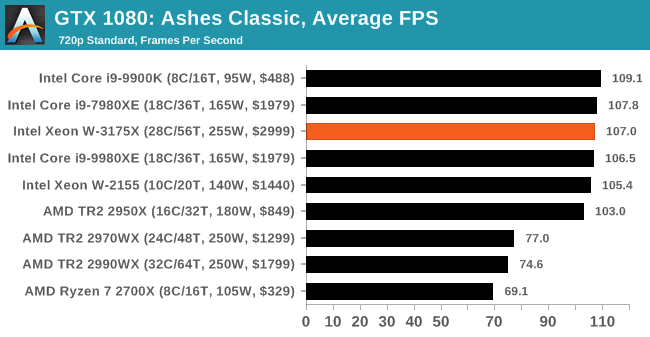 |
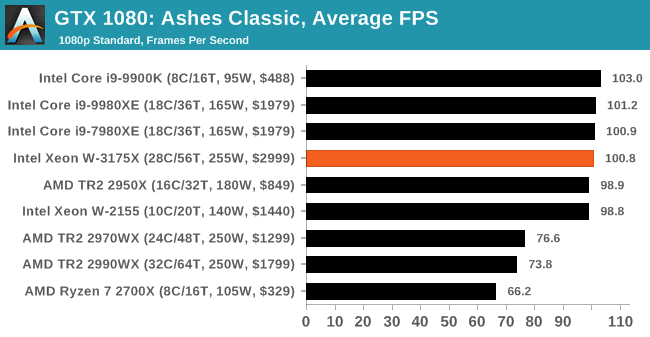 |
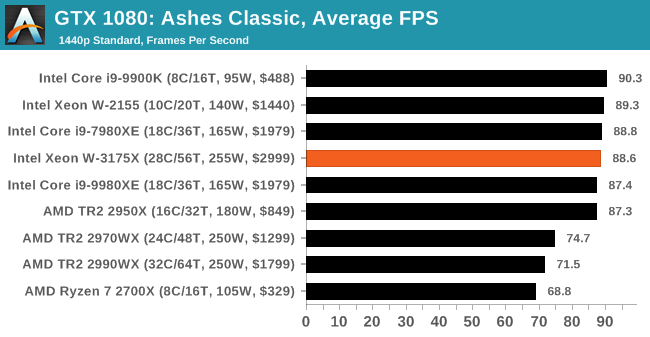 |
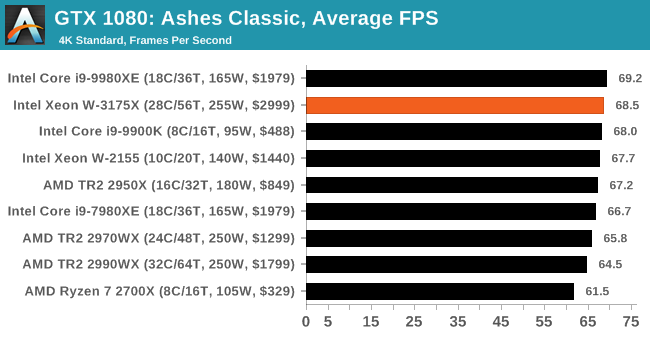 |
| 95th Percentile | 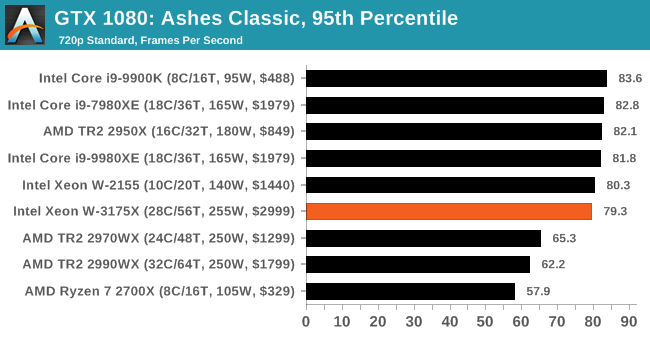 |
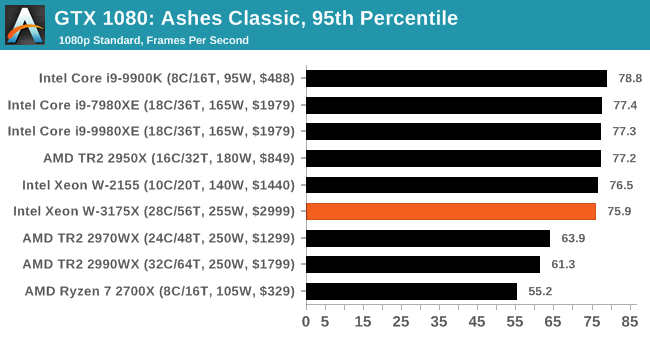 |
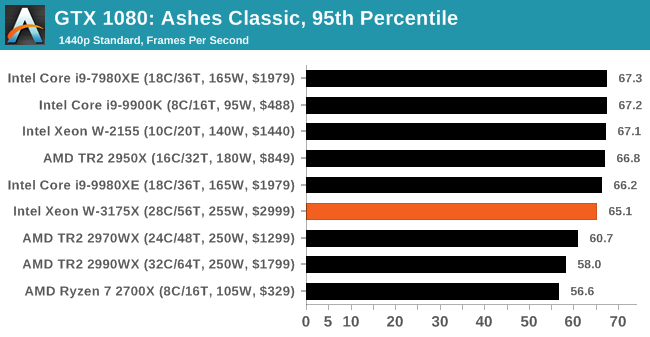 |
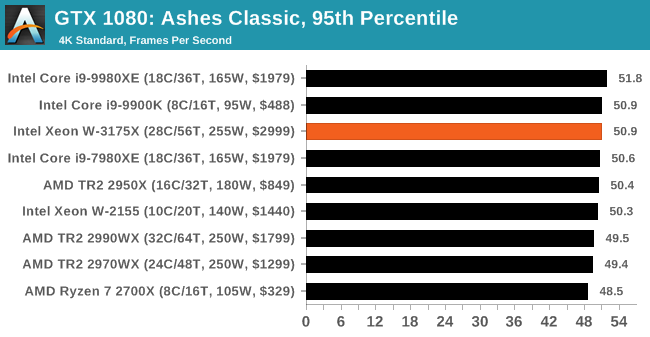 |
.


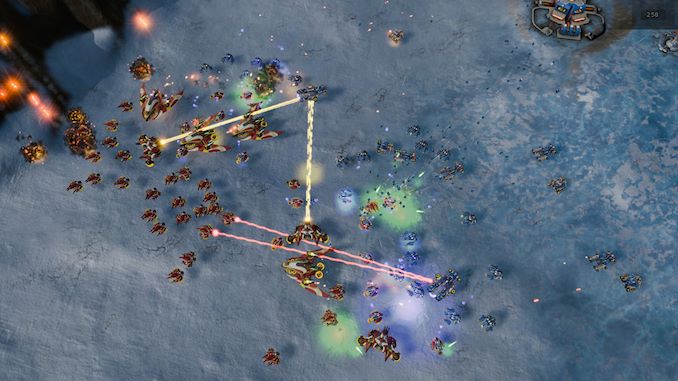









136 Comments
View All Comments
Icehawk - Thursday, January 31, 2019 - link
Yup. At the desktop level we have things like Adobe for $1k/seat/yr.Our big iron costs an order of magnitude more than these machines (recent orders were $150k ea and were mid-spec HP boxes). In the end most of the costs of a big server are memory and storage (SSDs). The high heat/energy consumption of this setup would be a concern, especially if in a colo.
jardows2 - Wednesday, January 30, 2019 - link
What are you rambling on about? It's a solid performing product, at a much reduced price than Intel's normal markup. I don't get where you come off thinking this is a fanboy post, and you totally missed my point - why is it limited to so few pieces? In Intel's lineup, it's a winner, and there are plenty of people in workstation markets who will only buy systems with Intel CPUs. So for Intel to make a good performing product, at a much lower than normal for Intel price, but only make a couple thousand of them? What's going on over there?edzieba - Thursday, January 31, 2019 - link
Because this is a cherry-picked part from a low-run die production. Intel don't make many XCC dies, and only a handful will be able to tolerate the high voltages and frequencies of this part across all 28 cores. It's also not going to be a big earner at $3000, that may break even on production but probably a loss overall when you take R&D into account.mapesdhs - Saturday, February 2, 2019 - link
A movie company I know buys systems in such bulk, a CPU/system like this wouldn't even show up on their radar. They prefer systems they can buy lots of, for multiple sites with a common setup.People are arguing here about A vs. B, about the CPU cost, but as many have pointed out it's often the sw cost and availability which determine what a company will purchase. As for workstation use, especially the prosumer market, that has its own set of issues, especially whether a particular app is written well enough to exploit so many cores. Blender is, but Premiere isn't.
FMinus - Friday, February 1, 2019 - link
Or you can get two TR 2970W system and make them work in tandem for what I would think would be almost half the price at this point, considering you can buy this Intel gem only pre-built for probably well bloated prices.SanX - Friday, February 1, 2019 - link
Intel are killing good at particle movement -- 4x faster then TR2. Till AMD makes AVX512 they are still dead for scienceET - Wednesday, January 30, 2019 - link
I find it amazing how application dependent performance is. Whether a product is a good buy depends so much on precisely what you're going to do with it, down to the application level.Still, on the whole, it looks like Intel has little to offer over AMD's much cheaper Threadripper platform.
BigMamaInHouse - Wednesday, January 30, 2019 - link
I think soon we gonna see "Leaks" about new TR64 cores, this "5GHZ 28C" stunt made AMD to release 2990WX instead just 24C 2970WX, now after the Fail attempt by Intel - We gonna see new leaks :-).FMinus - Friday, February 1, 2019 - link
Considering AMD was attending the same trade show, where Intel announced this 28 core chip and AMD a day later announced the new TR lineup, I'd say AMD planned to release the 2990WX regardless of what Intel had.mapesdhs - Saturday, February 2, 2019 - link
Yes, but the tinfoil hat industry is strong. :D